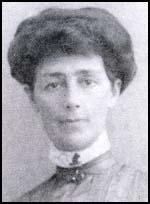Vida Goldstein

Vida Goldstein was born in Victoria, New South Wales on 13th April 1869. When she was a child the family moved to Melbourne and she attended the Ladies' Presbyterian College. As a teenager she helped her mother collect names for a petition that demanded votes for women.
Goldstein ran a co-educational preparatory school. In 1899 she became the leader of the United Council for Women's Suffrage. She immediately wrote to the National Union of Suffrage Societies in London to ask if her organisation to be affiliated. Millicent Fawcett agreed to this proposal.
In 1900 Goldstein founded the Australian Women's Sphere. In 1902 she was elected secretary of the International Women's Suffrage Alliance in Washington. According to Elizabeth Crawford, the author of The Suffragette Movement (1999): "Vida Goldstein... spoke at a hearing before the Committee on the Judiciary of the House of Representatives at which Carrie Chapman Catt asked that the House should appoint a committee to investigate the results of women suffrage in operation."
In 1903 Goldstein stood as Woman's candidate in the first Australian Federal Elections, the first woman candidate in the British Empire ever to stand for parliament. Although unsuccessful, she polled 51,497 votes. Over the next 14 years she unsuccessfully tried on five occasions to be elected to the legislature.
In 1911 Goldstein visited England and spoke at several meetings. The Men's League For Women's Suffrage gave a dinner in her honour. This was attended by Millicent Fawcett (National Union of Suffrage Societies), Christabel Pankhurst (Women Social & Political Union) and Charlotte Despard (Women's Freedom League).
On 17th June, 1911 Vida Goldstein attended the Women's Coronation Procession to the Royal Albert Hall. The speakers included Goldstein, Emmeline Pankhurst, Christabel Pankhurst, Emmeline Pethick-Lawrence and Annie Besant.
While in England she visited Eagle House near Batheaston, the home of WSPU member, Mary Blathwayt. Her father, Colonel Linley Blathwayt was sympathetic to the the cause and on 23rd July, 1911, he planted a tree, a Ilex Aquifolium Nigrescens, in her honour in his suffragette arboretum in a field adjacent to the house.
During the First World War she joined forces with Adela Pankhurst to establish the Australian Women's Peace Army. Adela believed that her actions were true to her father's belief in international socialism. She wrote to Sylvia Pankhurst that like her she was "carrying out her father's work". Emmeline Pankhurst completely rejected this approach and told Sylvia that she was "ashamed to know where you and Adela stand." Edgar Ross, a fellow campaigner against the war in Melbourne later recalled: "What I remember most about her was her courage. She would stand, unfearing, in front of jingo-mad soldiers heckling her when speaking on the platform."
In 1919 Vida Goldstein represented Australia at the Women's International League for Peace & Freedom Conference in Zurich. On her return to Australia she campaigned for birth control clinics and for world disarmament.
Vida Goldstein died of cancer in South Yarra on 15th August 1949.
Primary Sources
(1) Mary Blathwayt, diary entry (17th June, 1911)
This afternoon took the tram to the Embankment. we formed up for the Women's Coronation Procession at 4.30 and started at 5.30. Got to the Albert Hall about 7.30. The meeting began at 6.30. Speakers were Emmeline Pankhurst, Christabel Pankhurst, Emmeline Pethick Lawrence, Vida Goldstein and Annie Besant.
(2) Emily Blathwayt, diary entry (19th June, 1911)
Now the WSPU have passed their £100,000... Mary was in the Albert Hall, where Vida Goldstein among others spoke very well. Mary met such numbers of people she knew. she says she seemed to spend her time shaking hands with people.
